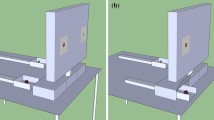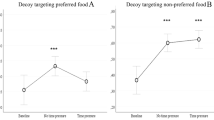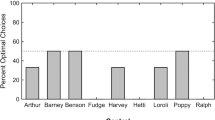Abstract
Traditional economic theories assume decision makers in multialternative choice tasks “assign” a value to each option and then express rational preferences. Here, I report an apparent violation of such rationality in gray jays (Perisoreus canadensis). I tested the jays’ preference in a quaternary choice task where three options were the same color and the fourth option was a different color. All options offered an identical food reward and so the strictly rational expectation was that subjects would choose the odd-colored option in 25% of choices. In clear disagreement, every subject chose the odd option more frequently than expected. I speculate as to how this surprising preference for oddity might have been ecologically rational: by using a unique-choice heuristic, the jays might have been able to bypass a deliberative phase of the decision process and devote more attention to scanning for predators. Alternatively, it is conceivable that the jays did not prefer oddity per se. Instead, they might have used a hierarchical process, assigning options to color categories and then choosing between categories. If so, their behavior matches expectation after all (on average, subjects chose the odd option 50% of the time). It should be straightforward to test these competing hypotheses. The current results can be viewed as a new example of how simple mechanisms sometimes produce economically puzzling yet ecologically rational decision making.

Similar content being viewed by others
References
Ariely D, Levav J (2000) Sequential choice in group settings: taking the road less traveled and less enjoyed. J Consum Res 27:279–290
Bateson M, Healy SD, Hurly TA (2002) Irrational choices in hummingbird foraging behaviour. Anim Behav 63:587–596
Bateson M, Healy SD, Hurly TA (2003) Context-dependent foraging decisions in rufous hummingbirds. Proc R Soc Lond B Biol Sci 270:1271–1276
Benjamini Y, Hochberg Y (1995) Controlling the false discovery rate: a practical and powerful approach to multiple testing. J R Stat Soc B 57:289–300
Bogacz R, Brown E, Moehlis J, Holmes P, Cohen JD (2006) The physics of optimal decision making: a formal analysis of models of performance in two-alternative forced-choice tasks. Psychol Rev 113:700–765
Cain ME, Saucier DA, Bardo MT (2005) Novelty seeking and drug use: contribution of an animal model. Exp Clin Pychopharmacol 13:367–375
Dukas R, Kamil AC (2000) The cost of limited attention in blue jays. Behav Ecol 11:502–506
Eagan LC, Santos LR, Bloom P (2007) The origins of cognitive dissonance: evidence from children and monkeys. Psychol Sci 18:978–983
Fox RA, Millam JR (2007) Novelty and individual differences influence neophobia in orange-winged Amazon parrots (Amazona amazonica). Appl Anim Behav Sci 104:107–115
Gigerenzer G, Todd PM, the ABC Research Group (1999) Simple heuristics that make us smart. Oxford University Press, New York
Houston AI, McNamara JM, Steer MD (2007a) Do we expect natural selection to produce rational behaviour? Philos Trans R Soc Lond B Biol Sci 362:1531–1543
Houston AI, McNamara JM, Steer MD (2007b) Violations of transitivity under fitness maximization. Biol Lett 3:365–367
Hurly TA, Oseen MD (1999) Context-dependent, risk-sensitive foraging preferences in wild rufous hummingbirds. Anim Behav 58:59–66
Hutchinson JMC, Gigerenzer G (2005a) Simple heuristics and rules of thumb: where psychologists and biologists might meet. Behav Processes 69:97–124
Hutchinson JMC, Gigerenzer G (2005b) Connecting behavioural biologists and psychologists: clarifying distinctions and suggestions for further work. Behav Processes 69:159–163
Kaby U, Lind J (2003) What limits predator detection in blue tits (Parus caeruleus): posture, task or orientation? Behav Ecol Sociobiol 54:534–538
Kacelnik A, Marsh B (2002) Cost can increase preference in starlings. Anim Behav 63:245–250
Kahneman D, Tversky A (1996) On the reality of cognitive illusions. Psychol Rev 103:582–591
Kokko H, Jennions MD, Houde A (2007) Evolution of frequency-dependent mate choice: keeping up with fashion trends. Proc R Soc Lond B Biol Sci 274:1317–1324
Lo CC, Wang XJ (2006) Cortico-basal ganglia circuit mechanism for a decision threshold in reaction time tasks. Nat Neurosci 9:956–963
Marples NM, Roper TJ, Harper DGC (1998) Responses of wild birds to novel prey: evidence of dietary conservatism. Oikos 83:161–165
Nevai AL, Waite TA, Passino KP (2007) State-dependent choice and ecological rationality. J Theor Biol 247:471–479
Ratcliff R, McKoon G (2008) The diffusion decision model: theory and data for two-choice decision tasks. Neural Comput 20:873–922
Ratcliff R, Cherian A, Segraves M (2003) A comparison of macaque behavior and superior colliculus neuronal activity to predictions from models of two-choice decisions. J Neurophysiol 90:1392–1407
Read D, Loewenstein G (1995) Diversification bias: explaining the discrepancy in variety seeking between combined and separated choices. J Exp Psychol 1:34–49
Roe RM, Busemeyer JR, Townsend JT (2001) Multialternative decision field theory: a dynamic connectionist model of decision making. Psychol Rev 108:370–392
Schuck-Paim C, Kacelnik A (2007) Choice processes in multialternative decision making. Behav Ecol 18:541–550
Shafir S (1994) Intransitivity of preferences in honey-bees: support for comparative-evaluation of foraging options. Anim Behav 48:55–67
Shafir S, Waite TA, Smith B (2002) Context-dependent violations of rational choice in honeybees (Apis mellifera) and gray jays (Perisoreus canadensis). Behav Ecol Sociobiol 51:180–187
Simon HA (1990) Invariants of human behavior. Annu Rev Psychol 41:1–19
Stephens DW, Kerr B, Fernandez-Juricic E (2004) Impulsiveness without discounting: the ecological rationality hypothesis. Proc R Soc Lond B Biol Sci 271:2459–2465
SPSS (2006) SPSS version 15.0. SPSS, Chicago
Strickland D, Ouellet H (1993) Gray jay. In: Poole A, Stettenheim P, Gill F (eds) The birds of North America, no. 40. The Academy of Natural Sciences, Philadelphia
Strickland D, Waite TA (2001) Does initial suppression of allofeeding in small jays help to conceal their nests? Can J Zool 79:2128–2146
Sugrue LP, Corrado GS, Newsome WT (2005) Choosing the greater of two goods: neural currencies for valuation and decision making. Nat Rev Neurosci 6:363–375
Todd PM, Gigerenzer G (2003) Bounding rationality to the world. J Econ Psychol 24:143–165
Tversky A, Simonson I (1993) Context-dependent preferences. Manage Sci 39:1179–1189
Waite TA (2001a) Intransitive preferences by hoarding gray jays. Behav Ecol Sociobiol 50:116–121
Waite TA (2001b) Background context and decision making in hoarding gray jays. Behav Ecol 12:318–324
Waite TA (2002) Interruptions improve choice performance in gray jays: prolonged information processing versus minimization of costly errors. Anim Cogn 5:209–214
Waite TA, Campbell LG (2006) Controlling the false discovery rate and increasing statistical power in ecological studies. EcoScience 13:439–442
Waite TA, Passino KM (2006) Paradoxical preferences when options are identical. Behav Ecol Sociobiol 59:777–785
Waite TA, Strickland D (2006) Climate change and the demographic demise of a hoarding bird living on the edge. Proc R Soc Lond B Biol Sci 273:2809–2813
Acknowledgments
I thank A. D’Orazio, M. Spathelf, and especially P. M. Todd and two anonymous reviewers for helpful comments on the manuscript; Ian Hamilton for insightful discussion; Seven Main, Soul Sistas, and Stauf’s for providing pleasant workspace; and D. Strickland for ongoing collaboration. The experiment complied with the laws of Canada and was done with approval of the Ohio State University Institutional Animal Care and Use Committee, protocol 00A0148.
Author information
Authors and Affiliations
Corresponding author
Rights and permissions
About this article
Cite this article
Waite, T.A. Preference for oddity: uniqueness heuristic or hierarchical choice process?. Anim Cogn 11, 707–713 (2008). https://doi.org/10.1007/s10071-008-0162-3
Received:
Revised:
Accepted:
Published:
Issue Date:
DOI: https://doi.org/10.1007/s10071-008-0162-3




